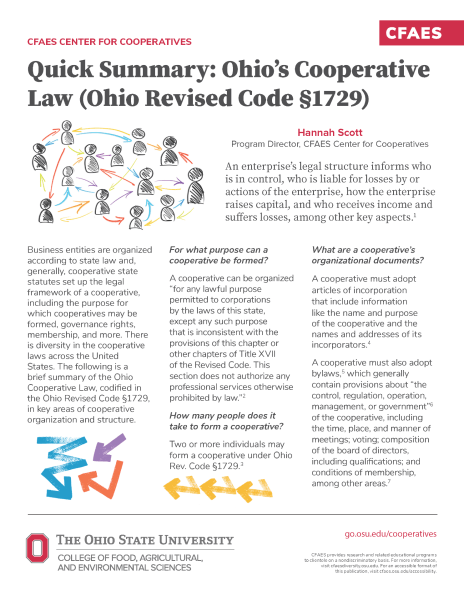
Here in Ohio, the growing season is ramping up quickly! In some communities, farmers markets have already kicked off their season and in others, local food enthusiasts won’t have to wait long to enjoy the market. The estimated 8,000+ farmers markets across the United States[1] are an important way farmers sell to customers directly.
Based on the most recent U.S. Department of Agriculture (USDA) Census of Agriculture, in Ohio an estimated 8% of farms sell approximately $90 million worth of products directly to consumers.[2]
Advocates of farmers markets, like the Farmers Market Coalition, cite benefits like:
- Helping farm businesses succeed – Farmers with direct-to-consumer sales are more likely to remain in business than other farms, according to USDA data.[3] Producers with farms that sell food through direct channels, like farmers markets, were more likely than all U.S. farms to be female and aged 34 or younger.[4]
- Creating community food access points – 99% of farmers markets responding to a 2019 USDA survey sell fruits and vegetables and about half of responding markets accepted Federal Nutrition Programs like Supplemental Nutrition Assistance (SNAP)[5]
- Positive community impact – About half of farmers markets responding to a 2019 USDA survey had a paid market manager and just over 5,000 markets across the U.S. engaged over 31,000 volunteers.[6]

Farmers Markets and Business Structures
Starting and growing a successful farmers market involves many moving parts – building a community of farmers, engaging with local community leaders and patrons, effective marketing, and strong operational plans. Among the important aspects for new and established markets to consider is their business structure – like whether the market is an independent legal entity like a corporation or part of a larger umbrella organization. A market’s business structure can impact how decisions are made for a market, the extent of personal liability for market leaders, eligibility for certain types of funding like grants or charitable donations, how the market is taxed, and more.[7]
The Farmers Market Legal Toolkit from the Center for Agriculture and Food Systems at Vermont Law School provides helpful information about business structures for farmers markets, along with information about accepting public benefits and managing risks at markets.
Cooperatives as a Business Structure for Farmers Markets
 Cooperatives are one of various business structure choices for farmers markets. Cooperatives are member owned and controlled businesses that distribute benefits based on use and grounded in principles like democratic member control and concern for community.[8] Cooperatives operate across sectors from insurance and financial services to housing, purchasing, and utilities. In agriculture, cooperatives market various food and agriculture products, procure supplies and inputs, and provide services, like financial services.[9]
Cooperatives are one of various business structure choices for farmers markets. Cooperatives are member owned and controlled businesses that distribute benefits based on use and grounded in principles like democratic member control and concern for community.[8] Cooperatives operate across sectors from insurance and financial services to housing, purchasing, and utilities. In agriculture, cooperatives market various food and agriculture products, procure supplies and inputs, and provide services, like financial services.[9]
Farmers markets structured as cooperatives might be owned and governed by farmers who sell at the market, by community members who shop at the market, or by both groups in a “multistakeholder” cooperative.
Cooperative markets owned and governed by farmers are one form of marketing collaborations for farmers. Learn more about “Marketing Collaborations for Farmers” in our blog post here.
Some of the potential benefits of structuring a farmers market as a cooperative might include:
- Member engagement and decision-making – Many decisions for a cooperative are made by a board of directors elected from and by the members. Members elect the board and can cast their vote on certain major issues for the cooperative. Democratic control is a defining principle of cooperatives and members generally vote using a “one member, one vote” set up. Cooperatives generally distribute their profit to members based on their use of the business.[10]
- Community focus – As a business, the focus of a cooperative is on providing benefits to its members.[11] The internationally recognized cooperative principles highlight that “[c]ooperatives work for the sustainable development of their communities.”[12] This member and community orientation might create opportunities for cooperative farmers markets to develop a community-orientation and focus.
- Existence of the market beyond current leaders – Operating a farmers market can be a lot of work. To ensure the successful operation of a market well into the future, it may be important to consider how to effectively share or transfer responsibilities for leadership and how to create a stable structure. As independent legal entities that are governed by a board, cooperatives may have opportunities to share leadership responsibilities and generally can exist perpetually as long as appropriate formalities are met.[13]
- Limitation of liability and easily updated membership – Generally, cooperatives are legal entities created by filing appropriate forms with a state agency. As independent legal entities, generally the personal liability of each member in a cooperative is limited to the equity the member holds in the cooperative. Cooperatives set up as separate legal entities can add and remove members.[14]
However, cooperatives may have disadvantages compared to other potential business structures for farmers markets. For example, cooperative markets may be limited in their ability to legally use volunteers and unpaid staff compared to nonprofits, they may be limited in raising certain kinds of capital compared to corporations, and they rely on strong engagement and participation from members compared to structures that rely on just one or a few members like limited liability companies.[15]

Like any decisions for a business with varied and far-reaching consequences, those interested in exploring the right business structure in their specific situation should consult knowledgeable competent professionals, like attorneys, accountants, and others. This information is provided for educational purposes only. It is not legal advice. It is not a substitute for the potential need to consult with a competent attorney in the appropriate jurisdiction.
Take a deeper dive into the cooperative business model, including cooperative legal frameworks, governance, financial concepts, and more with Co-op Mastery: Beyond Cooperatives 101 at go.osu.edu/coopmastery.
References
[1] 2019 National Farmers Market Managers 2019 Summary. (Aug. 2020). U.S. Department of Agriculture National Agricultural Statistics Service. https://downloads.usda.library.cornell.edu/usda-esmis/files/pz50hd694/gx41n598k/jd473j98z/nfar0820.pdf
[2] Data from the 2022 Census of Agriculture “Ohio: Market Value of Agricultural Products Sold Including Landlord’s Share, Food Marketing Practices, and Value Added Products: 2022 and 2017” and “Ohio Historical highlights: 2022 and Earlier Census Years,” U.S. Department of Agriculture National Agricultural Statistics Service.
[3] Key, N. (2016). “Local Foods and Farm Business Survival and Growth.” U.S. Department of Agriculture Economic Research Service. https://www.ers.usda.gov/amber-waves/2016/march/local-foods-and-farm-business-survival-and-growth/
[4] Direct Farm Sales of Food: Results from the 2020 Local Food Marketing Practices Survey. U.S. Department of Agriculture National Agricultural Statistics Service. https://www.nass.usda.gov/Publications/Highlights/2022/local-foods.pdf
[5] National Farmers Market Managers. (Aug. 2020). U.S. Department of Agriculture National Agricultural Statistics Service. https://downloads.usda.library.cornell.edu/usda-esmis/files/pz50hd694/gx41n598k/jd473j98z/nfar0820.pdf
[6] National Farmers Market Managers. (Aug. 2020). U.S. Department of Agriculture National Agricultural Statistics Service. https://downloads.usda.library.cornell.edu/usda-esmis/files/pz50hd694/gx41n598k/jd473j98z/nfar0820.pdf
[7] “Why does the market’s business structure matter?” Farmers Market Legal Toolkit. Center for Agriculture and Food Systems, Vermont Law School. https://farmersmarketlegaltoolkit.org/business-structures/why-your-choice-matters/
[8] (2014). Co-op Essentials: What They Are and the Role of Members, Directors, Managers, and Employees. USDA Rural Development Cooperative Programs.
[9] Wadsworth, J., Lapp, K., & Rivera, J. (2021). Agricultural Cooperative Statistics 2019. Washington, D.C.: U.S. Department of Agriculture Rural Development Service Report 83.
[10] “Co-ops 101: An Introduction to Cooperatives.” (2012). U.S. Department of Agriculture Rural Development, Cooperative Information Report 55. Retrieved from http://www.rd.usda.gov/files/cir55.pdf
[11] Zueli, K. & Cropp, R. (2014). “Cooperatives: Principles and practices in the 21st century.” UW Extension.
[12] “Cooperative identity, values & principles.” (n.d.). International Cooperative Alliance. Retrieved from https://www.ica.coop/en/cooperatives/cooperative-identity
[13] “Legal Foundations of a Cooperative.” (1995). U.S. Department of Agriculture Rural Business – Cooperative Service, Cooperative Information Report 45, Section 9. Retrieved from https://www.rd.usda.gov/sites/default/files/CIR45-9.pdf
[14] “Legal Foundations of a Cooperative.” (1995). U.S. Department of Agriculture Rural Business – Cooperative Service, Cooperative Information Report 45, Section 9. Retrieved from https://www.rd.usda.gov/sites/default/files/CIR45-9.pdf
[15] “Cooperatives.” Farmers Market Legal Toolkit. Center for Agriculture and Food Systems, Vermont Law School. https://farmersmarketlegaltoolkit.org/business-structures/cooperatives/#topic-overview










